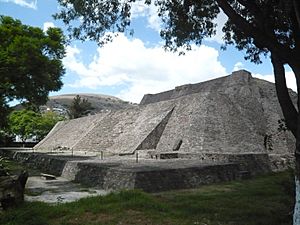Tenayuca facts for kids
Quick facts for kids Pyramid of Tenayuca |
|
|---|---|

The Aztec pyramid of Tenayuca
|
|
| Region | Valley of Mexico |
| Status | preserved, with museum |
| Location | |
| Location | Greater Mexico City |
| Municipality | Tlalnepantla de Baz |
| State | Mexico State |
| Architecture | |
| Architectural type | Temple |
| Architectural style | Aztec |
| Specifications | |
| Direction of façade | West |
| Length | 52 meters |
| Width | 60 meters |
| Website | |
| Tenayuca at INAH | |
Tenayuca is an ancient place in the Valley of Mexico. It was built long ago, even before Christopher Columbus arrived. This site was once a city right on the edge of Lake Texcoco. Today, it's about 10 kilometers northwest of what is now Mexico City.
Tenayuca was super important because it was the first capital city of the Chichimec people. They were nomadic tribes who traveled a lot before settling down and building their own empire here.
Contents
What Does Tenayuca Mean?
Tenayuca means "walled place" in the Nahuatl language. This name probably described the city's strong walls.
Where is Tenayuca Located?
You can find the ancient temple of Tenayuca in San Bartolo Tenayuca. This area is part of Tlalnepantla de Baz in Mexico State. It's now inside the big city area of Greater Mexico City.
The History of Tenayuca
Some stories say that King Xolotl founded Tenayuca around 1224. He was a legendary ruler of the Chichimec tribe. This tribe settled in the Valley of Mexico after the powerful Toltec empire fell.
Early Rulers and Changes
King Xolotl was followed by Nopaltzin, who made the Chichimec empire stronger. His son, Tlotzin, then became the lord of Tenayuca. Later, Nopaltzin's successor, Quinatzin, moved the main Chichimec power to Texcoco. This made Tenayuca less important.
Tenayuca's Ancient Roots
However, archaeologists have found older remains at Tenayuca. These show that people lived there long before King Xolotl's time. The population grew a lot after the fall of Tula, another ancient city. Tenayuca then became a strong regional power.
Alliances and Conquests
In the late 1200s, the ruler of Tenayuca, Tochintecuhtli, teamed up with Huetzin. Huetzin was the lord of the Acolhua people from Coatlichán. Together, they controlled a large part of the central Valley of Mexico.
By the mid-1300s, Tenayuca's power began to fade. It was conquered by a nearby city called Azcapotzalco. Around 1434, Tenochtitlan conquered Tenayuca, making it part of the powerful Aztec Empire.
Tenayuca During the Spanish Conquest
When the Spanish arrived, Tenayuca was still an active place. There was even fighting there in 1520. The Spanish explorer Bernal Díaz del Castillo called Tenayuca the "town of the serpents."
Eventually, the site was left empty. Mexican archaeologists rediscovered it during excavations in 1925.
How Aztec Temples Were Built
Aztec temple building styles really grew at Tenayuca. It has the oldest example of a special Aztec design: the double pyramid. This design has two temples on top of one joined pyramid base.
After Tenayuca became part of the Aztec Empire, the Aztecs copied this cool style. They used it to build temples for their own gods. The temple of Tenayuca is better preserved than a similar one in Tlatelolco. Its wall of serpents is still mostly standing on three sides.
Exploring the Tenayuca Site

The site has a huge, flat-topped pyramid. A double staircase goes up the western side. This is where the twin temples of Tlaloc (the rain god) and Huitzilopochtli (the sun and war god) once stood. Tlaloc's temple was on the north side, and Huitzilopochtli's was on the south.
Some of the temple steps have carvings of year-symbols. These include knives, circles, and shields. South of the stairway, at ground level, is a platform with sculptures of crossed bones and skulls.
Layers of Construction
Like many ancient temples, Tenayuca was built in layers. New parts were added on top of older ones. The pyramid grew bigger through six building phases. But its basic shape stayed the same.
The original double pyramid was made larger five times. The first time was probably in 1299. Then, new layers were added about every 52 years. The last building phase was likely around 1507. At this point, the pyramid was 62 meters wide and 50 meters deep.
You can see Aztec influence from the third stage, around 1351. The later stages were purely Aztec in style. This is shown by the sloping sides of the pyramid, unlike the straight walls of earlier stages.
The Wall of Serpents
The grand temple base is surrounded by a coatepantli. This Nahuatl word means "wall of serpents." It's a low platform holding 138 stone snake sculptures. Their bodies were once covered in plaster and painted in bright colors, with black scales.
On the north and south sides of the temple, at ground level, are two large coiled snake sculptures. The crests on their heads have markings that look like stars. These identify them as Xiuhcoatl, the fire serpent. All the snake sculptures around the temple were linked to fire and sun worship.
There are also several altars and shrines nearby that archaeologists dug up. Some of these also have snake sculptures.
Residential Area
About 200 meters from the main temple are the remains of what might have been a fancy living area. Some rooms still have their plaster floors. Archaeologists call this area Tenayuca II. It also seems to have been built in different stages over time.
The temple of Tenayuca is cared for by the Instituto Nacional de Antropología e Historia. This is Mexico's National Institute of Anthropology and History. The site is open for everyone to visit.
Images for kids
See also
 In Spanish: Tenayuca para niños
In Spanish: Tenayuca para niños
- Aztecs
- Teopanzolco
- Tlatelolco (archaeological site)
- List of Mesoamerican pyramids













